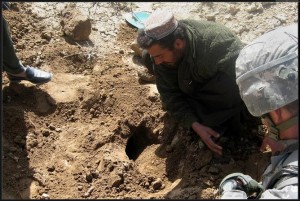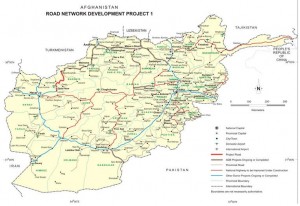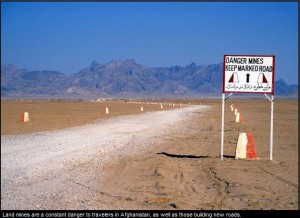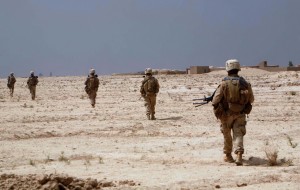The Wall Street Journal gives us an account of several terrible, horrible, no good, very bad days in Afghanistan that bear our attention. But before that, a few preliminaries.
As best as I can determine, the U.S. Army is on a mission to find itself, or self actualize, or something else like that. So is the Corps, just in a different way. The Corps is trying to figure out this whole Expeditionary concept with very expensive amphibious fighting vehicles that would never be used except for an amphibious assault (an assault the target of which we simply can’t fathom at the moment).
But the Army mission is entirely different. The Army is trying to divide itself into Thomas P.M. Barnett’s Leviathan and Sysadmin, with the SF / SOF being the Leviathan and the balance of the forces being the softer side. The Leviathan does direct action kinetics. They don’t participate in the softer side of counterinsurgency; they play offense, while the general purpose forces play defense.
The Marines have no such division of labor (except perhaps the division of infantry and otherwise). I have weighed in explaining my opposition to this model. It is almost as bad an idea to separate the SOF from COIN as it is to separate general purpose forces from direct action kinetics. Both are profoundly misguided, still-born notions.
Naturally, I objected when the narrative concerning General McKiernan began to devolve into nay saying and charges of incompetence. I strongly supported McKiernan, and then even more so. My reaction to General Stanley McChrystal was that the Afghanistan campaign will turn into even more of a SOF direct action program against high value targets, in which case I believe that it’s better to leave Afghanistan entirely and deploy back to the states (for both SOF and GPF). It won’t work.
I also had not seen any valid objection or problematic instance concerning General McKiernan’s leadership – at least, not until now. But a few more words before we dive into the terrible, horrible, no good, very bad counterinsurgency. To be sure, while there were many instances of direct action kinetics by the Marines in Anbar, Iraq (after all, they are Marines), all counterinsurgency is not kinetics. Sometimes the methods are soft. Other times, the methods may follow Edward Luttwak and Ralph Peters more so than Nagl and Petraeus.
There are many examples of things that can make families and particularly heads of households very uncomfortable, such as aggressive raids in the middle of the night, cordon and knock doors down and root around homes for weapons caches rather than cordon and knock, and other tactics that don’t bear discussion in a forum like this one.
But no matter how hard or soft a tactic or set of tactics, they all have one thing in common: behavior modification. No tactic is applied in a vacuum. They all have as their goal reliance on the government, information sharing, development of intelligence, and other such things as are conducive to the campaign.
So it’s valid to ignore the wishes of the people as long as there is a good reason for it and there is some remedy of amelioration. Does the local population not respond to tribal Sheiks? Do they respond better to block captains, or Mukhtars? Fine. Then use this to your advantage and set up gated communities and Mukhtars in responsible charge. One understands the human terrain and works with what he has been given.
Now to the terrible, horrible, no good, very bad counterinsurgency in Afghanistan.

The karez originated in southwest Persia around 1000 B.C. The hand-dug underground canals carry water from aquifers in the hills to villages and fields. The system irrigates about 75% of Zabul’s grapes, wheat and almonds. Villagers and soldiers uncovered a vertical maintenance shaft for canals near the base.
By MICHAEL M. PHILLIPS
Karezgay, Afghanistan
Deep beneath the desolate landscape here are miles of canals that have watered wheat fields and vineyards for untold generations. They’re also at the center of a dispute that handed the Taliban a propaganda victory and angered the very people the U.S. military hopes to win over through its troop surge.
Rushing to expand a base to fit the new forces, American commanders seized farmland and built on top of these ancient underground-irrigation systems. The blunder is an indication of how fragile the effort to win public backing for the U.S.-led war can be. In some cases, the tension is over civilian casualties; in others, it’s about the corruption of U.S. allies in the Afghan government. Here, it’s an accidental clash of infrastructure technologies separated by a few yards of dirt and 3,000 years.
Rahmatullah, an elder from near Forward Operating Base Wolverine in Zabul province, complains about the U.S. base’s expansion.
Now American and Afghan officials are scrambling to mend relations with the farmers, dispatching a mullah to pray with them, a lawyer to pay them and engineers to redesign the base to accommodate them.
“If before we put the first U.S. soldier on the ground, we alienate the closest village to the…base, we’re putting the thing in reverse before we even get started,” says Lt. Col. William “Clete” Schaper, lead engineer on the expansion of Forward Operating Base Wolverine, one of more than two dozen U.S. posts being enlarged.
The underground canals, called karez, originated in southwest Persia around 1,000 B.C. before migrating to Afghanistan. When Genghis Khan invaded in 1221 A.D., locals took shelter there. They did the same after the Soviets invaded in 1979. In some parts of Afghanistan today, insurgent fighters use the tunnels to ambush coalition troops and escape unseen.
Karezgay is in Zabul Province, or “Talibanistan,” as U.S. officers here joke. Zabul is an ideal candidate for some of the 21,000 new troops that President Barack Obama has directed to Afghanistan. Entire districts of the province are insurgent-controlled, and coalition forces here are barely sufficient to protect the highway that passes through Zabul.
The goal is for new troops to clear out insurgents, allowing Afghan authorities to win local allegiance with education, health care, security and other services. But the troops will need a place to stay, so last fall the Army started planning to expand FOB Wolverine, now a small post, to accommodate 1,000 soldiers, a helicopter battalion and a 6,000-foot runway. The base perimeter has expanded to two miles around; engineers expect that to triple in the near future. “It was an engineer looking at a map and saying, ‘We need this much room,’ and drawing a box,” says Lt. Col. Schaper.
The Army didn’t take into account the karez, which consist of hand-dug underground canals that carry water from aquifers in the hills to villages and fields. Every 50 or so feet is a vertical shaft used for maintenance. The system irrigates about 75% of Zabul’s grapes, wheat and almonds.
The karez “are the linchpin of their entire civilization here,” says Capt. Paul Tanghe, who advises the Afghan National Army battalion in Karezgay.
In December, Capt. Tanghe and other U.S. advisers noticed surveying work under way, figured out the Army had big plans and realized locals would be in an uproar. They emailed Lt. Col. Schaper, warning of the expansion’s likely impact. U.S. and Afghan officials then invited village elders to Karezgay for a meeting, called a shura, to discuss the plans.
The Taliban were a step ahead. They hosted their own shura at the mosque, where they preached an anti-U.S. message, according to Capt. Tanghe.
The elders left the mosque and walked to the district center for the government shura. Coalition officials touted the benefits of jobs and an airfield, to little effect. One by one, each elder mouthed the Taliban-approved line: The U.S. Army is here to steal land, destroy the karez and force the locals to move. One mullah charged that airplanes would cause pregnant women to lose their babies, Capt. Tanghe says.
Just one village, Bao Kala, spoke in support of the expansion, an act defying the Taliban. One night last fall, Taliban militants burst into the home of a Bao Kala elder and schoolteacher, Bismillah Amin, 42. They frog-marched him barefoot for more than a mile to a gathering of armed fighters, who ordered him to stop teaching. To reinforce the warning, they sliced off his left ear.
After the shura, the coalition sent a veterinarian to de-worm livestock in Bao Kala and funded a project to clean out its tunnels.
In late February, with the surge approaching, crews began expanding FOB Wolverine’s boundaries, absorbing neighboring fields and vertical openings of the karez system.
In March, the Army sent a hydrologist to study the impact that construction was having on water supplies in one village. “The resulting water production loss experienced by Bowragay Village karez system supports Taliban claims of base expansion negatively impacting the community and confounds counterinsurgency operations,” the hydrologist’s internal report said.
Last month, U.S. Gen. David McKiernan, the top allied commander in Afghanistan until he was ousted earlier this week, visited Zabul and found himself buttonholed by angry elders. The expansion, they said, was destroying their livelihoods. Gen. McKiernan ordered a coalition lawyer, Col. Jody Prescott, to Karezgay and arrange compensation.
Afghan officials called another shura late last month. An Afghan army mullah opened the event by reciting verses from the Koran. Soldiers posted a blue banner that read, “Islam unifies our nation.”
Lt. Col. Schaper took the podium. “Once we establish security, we’ll be able to grow the district both economically and with our education programs,” he said. “We realize it does us no good to expand the base and bring security, if we ruin your crops.”
Salamuddin, a 48-year-old farmer with a black turban and a fierce black gaze, swept to the podium to speak. U.S. barbed wire now crosses his property, he said, and 160 acres of it are on the other side. “The karez is the main source of water for the village, but the Army has taken our karez and now it’s inside the base,” he said. “The village is nothing without our karez.” He shouted to the other elders: “Do you want your rights?”
“Yes!” they yelled back.
Lt. Col. Schaper pleaded for patience. “If we can avoid karezes and orchards, we will do that,” he promised. “We are not going to come in and take anyone’s land without compensation.”
Col. Prescott spent two weeks walking property lines and assessing damage claims, while Army engineers modified the base design. The original plan, for instance, put a waste-water treatment plant on top of a karez. The new plan puts it where it won’t disturb anything.
The Army realizes it stumbled with FOB Wolverine, and that if it fails to assuage local concerns, it risks confirming the Taliban message. Commanders also see an upside. Resolving the issue could strengthen the government’s weak position in Talibanistan.
“We’re fighting a counterinsurgency, and it’s all about narratives,” Capt. Tanghe said after the shura. “It doesn’t matter what really happened. It matters what they think happened.”
Well, let’s see. “The linchpin of their entire civilization,” and brass was aware of this. I’ll tell you what. Had I been in charge, the orders would have been as follows (without the many expletives): “Find the local commander of the Army Corps of Engineers, and get him on the phone now. This base is going to be moved. I don’t care what it takes or how long, or how much trouble it creates for the engineers. We won’t alienate the entire province of Zabul before we even get started here. If we have to turn this into a dozen smaller FOBs, I don’t care. Tell the men they can walk back and forth – tell them to talk to the locals on their way. It’ll be good for the campaign. Find a solution, and find it now, but tell the engineers that we’ll string ’em up if they don’t do this without destroying the aquification works.”
At any rate, trying to control the narrative is useless and an indicator of the stupidity of our presuppositions going into the campaign. We are losing the information war, and shuting down the aquification systems that sustained their forefathers and which will sustain their children’s children won’t do.
This is just terrible, horrible, no good, very bad counterinsurgency. No amount of money, hand shaking, talking, narrative-making, direct action kinetics, or anything else can undo such stolid interaction with the people. SOF, general purpose forces, it doesn’t matter. We must do better. We simply must do better.
Update: Thanks to Dave at the Small Wars Journal Blog for picking us for quote of the day.








